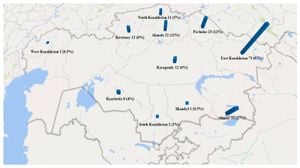Vietnam is accelerating its digital transformation initiatives across various sectors, particularly focusing on enhancing security and law enforcement through technology. This effort emerges as the nation aligns itself with the demands of the 4th industrial revolution, aiming to leverage digital solutions for improved public safety and streamlined governmental processes.
Local police forces have been at the forefront of this transformation, utilizing advanced technologies, including AI-integrated security cameras. According to Trung úy Nguyễn Duy Tiến of the Traffic Police Department of Quảng Yên, “Through the intelligent surveillance camera system, we are able to retrieve data within 200 meters, making it easier to track violations and identify license plates.” These cameras have drastically improved the ability of law enforcement to monitor and manage traffic conditions and criminal activities.
One recent case highlighted the system's effectiveness: groups of youths engaged in violent altercations were swiftly identified and apprehended through camera footage. The ability to track offenses and respond rapidly has created safer communities and increased compliance with laws—key goals of these digital initiatives.
The role of technology doesn't stop with surveillance. Platforms like Zalo have become indispensable for communication between law enforcement and the public. These online forums allow for 24/7 information flow, enhancing community engagement and awareness of criminal activities and procedural updates. This system also aids police investigations by providing timely information from citizens.
The nationwide digital transformation is rooted in strategic governmental frameworks, urging local and provincial leaders to embrace technological change. The Prime Minister has emphasized the necessity of these initiatives: “Digital transformation is not just technological; it’s about intervention and empowerment of citizens and governance.” This statement encapsulates the government's vision to create an interactive, responsive governance model.
These developments are not merely about improving surveillance or community engagement; they are part of broader national goals aimed at managing public safety efficiently and effectively. The establishment of national databases, standardized digital procedures, and public services is pivotal for supporting this transformation.
Experts have weighed in on the significance of these changes. Former Deputy Minister of Home Affairs, ông Nguyễn Tiến Dĩnh, pointed out, “Eliminated intermediate-level counties will improve efficiency and cut administrative costs,” highlighting the structural changes needed to support digital governance. Such reforms are consistent with global trends toward reducing bureaucratic layers, allowing for swifter decision-making and enhanced operational responses at the local level.
Dr. Trần Ngọc Đường, former Deputy Head of the National Assembly Office, expressed optimism about these initiatives, stating, “The disbanding of the intermediate administrative level aligns with global trends.” This reflects the shifting paradigm within Vietnam's governance model, where responsibilities can be more directly handled at the provincial and community levels.
Looking forward, the focus on digital transformation seems set to redefine public administration and law enforcement dynamics. Vietnam is readying itself for a future where technology plays an increasing role. The initiative’s success will hinge on continued investment in infrastructure, training, and citizen participation, facilitating a smoother transition to this new digital age.
With the ambition to establish Vietnam as a model of digital governance, leaders are eager to usher the country forward. The digital transformation initiatives are more than technical advancements; they represent Vietnam’s commitment to security, efficiency, and modernization for societal benefits.



